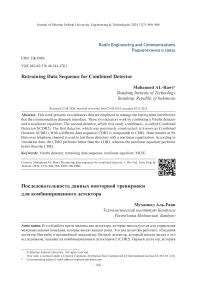Retraining data sequence for combined detector
Автор: Muhanned Al-Rawi
Журнал: Журнал Сибирского федерального университета. Серия: Техника и технологии @technologies-sfu
Рубрика: Информационно-коммуникационные технологии
Статья в выпуске: 7 т.17, 2024 года.
Бесплатный доступ
This work presents two detectors that are employed to manage the intersymbol interference that the communication channels introduce. These two detectors work by combining a Viterbi detector and a nonlinear equalizer. The second detector, which this study contributes, is called Combined Detector-2(CDR2). The first detector, which was previously constructed, is known as Combined Detector-1(CDR1). With a different data sequence, CDR2 is comparable to CDR1. Data transfer at 9.6 kbps over telephone channel is used to test these detectors with a nonlinear equalization. According to simulation data, the CDR2 performs better than the CDR1, whereas the nonlinear equalizer performs better than the CDR1.
Viterbi detector, retraining data sequence, nonlinear equalizer, mlse
Короткий адрес: https://sciup.org/146282959
IDR: 146282959 | УДК: 662.62:536.46:544.478.1
Текст научной статьи Retraining data sequence for combined detector
Цитирование: Муханнед Аль‑Рави. Последовательность данных повторной тренировки для комбинированного детектора / Муханнед Аль‑Рави // Журн. Сиб. федер. ун‑та. Техника и технологии, 2024, 17(7). С. 960–966. EDN: JIKXMK
The topic of the study in [10] is the development of coupled linear Viterbi detection, or optimal channel shortening, methods for ISI and MIMO channels. In the case of MIMO channel shortening, a trellis is used in place of a tree structure to represent MIMO signals. The feasible information rates of the shorter models are computed, and optimization is carried out from an information theoretical standpoint. All of the parts of the class's best detector are deduced from closed form expressions. Additionally, we demonstrate how the obtained model can be understood as a specific example of previously described channel shortening strategies.
A unique MLSD receiver structure for nonlinear channels is presented in the study in [8]. The NLC is viewed as a multiple input/many output system in order to develop this strategy. Then, using a unique variant of the space‑time whitened matched filter (ST‑WMF) created by modifying the Gram‑ Schmidt orthogonalization of the NLC's Volterra kernels, orthogonal signal components are computed. The ST‑WMF is followed by a VD with multidimensional branch metrics in the MLSD receiver. In the presence of highly dispersive NLC, the ST‑WMF's space orthogonalization and noise whitening provide an effective solution to reduce receiver complexity. In real‑world applications like intensity modulation/direct detection (IM/DD) optical channels, complexity reduction is essential. For instance, compared to an oversampled MLSD, the number of states of the VD in ST‑WMF‑MLSD required over a 10 Gb/s, 700 km, IM/DD fiber‑optic link is decreased by eight times.
Two low‑complexity 2‑D soft‑output Viterbi algorithm (SOVA) detector design methodologies are presented in the study in [12], and they each represent a different complexity versus performance trade‑off for multitrack joint 2‑D detection. This research demonstrates that, in comparison to the best symbol‑based 2‑D SOVA, it is possible to achieve nearly the same detection performance while reducing the silicon area by more than 60 % in three‑track joint detection. This is done through simulations and application‑specific integrated circuit design..
The adaptive near maximum likelihood detector, which combines pseudobinary and pseudoquaternary near maximum likelihood detection methods, is described in the article in [1]. According to simulation data, adaptive near maximum likelihood detector performance is slightly better than pseudoquaternary near maximum likelihood detector performance, but slightly poorer than pseudobinary near maximum likelihood detector performance.
Data transmission system
The model of the data transmission system is shown in Fig. 1. Each 4‑bit of binary data generated by the model's first component, a random data generator, is mapped into a 16‑point QAM constellation. As a result, the random number generator outputs the data symbol «si,» and all combinations of «1, «3, and «j1, «j3» are valid si values. The Quadrature Amplitude Modulation (QAM) transmitter, which comprises of a transmitter filter and a QAM modulator, then receives the data symbols. Before the signal is modulated, the transmitter filter, which is a low‑pass filter, limits the signal spectrum. The QAM transmitter's output is a QAM signal with an information rate of 2400x4bits=9600 b/s=9.6kb/s and a carrier frequency of 1800Hz. Before approaching the QAM receiver, the QAM transmitter's output travels over a telephone channel and is amplified by Additive White Gaussian Noise (AWGN). The QAM demodulator and receiver filter make up the QAM receiver. To provide realistic levels of intersymbol interference, the transmitter filter is used with the receiver filter, a low‑pass filter. The Least Mean Square (LMS) estimator uses the data symbols ri from the output of the QAM receiver to – 962 –
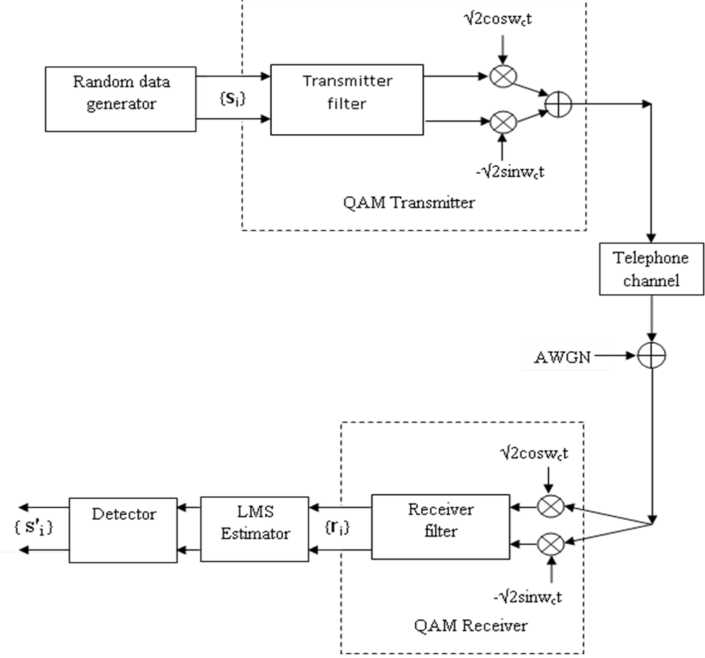
Fig. 1. Model of data transmission system
estimate the sampling impulse response (SIR) of the baseband telephone channel. Finally, the detector uses the data symbols ri and SIR to produce the observed symbols (s'i).
Detectors
Combined Detector-1(CDR1)
This detector, which was first created in [5], combines a Viterbi detector and a nonlinear equalizer, as seen in Fig. 2. The output of the VD, which is the identified sample s'i, is sent to the NLE through a linear feedforward transversal filter. To provide the input signal to VD, the output signal from this filter is subtracted from the sample ri that was received. Because of this, the NLE employs the quantized feedback correction to completely or partially remove ISI from the detector input signal, as will be discussed below.
The sampled impulse response of the baseband channel is given by (g+1) component row vector as h — [/lo^i
^g]
Thus the received sample value is

Where Si is the wanted transmitted sample, wi is noise component, and ISI is
ISI = У Si_jhj
J=i
The input signal to VD will be as follows, if ISI is completely eliminated by a linear feedforward transversal filter (assumed to be the case that the detected sample s'i= transmitted sample
xt = Siho + wt
In this scenario, VD functions as a straightforward threshold circuit, and CDR1 acts as an NLE. However, if a portion of the ISI is eliminated by a linear feedforward transversal filter, VD then deals with the remaining portion of the ISI, as mathematically depicted below.
The received sample in eq.2 can be rewritten as
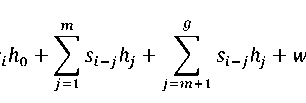
and the input to VD is j=m+l
Where the second part of ISI is removed by linear feedforward transversal filter.
It is evident from eq. 6 that as m increases, the portion of ISI addressed by VD grows and, consequently, the complexity of VD increases; nonetheless, performance will improve as m increases. In this case, m is set to one (m=1) to reduce the complexity of VD, and the input to VD becomes
Xi = Sih0 + si_1h1 + wt
From eq. 7, it is clear that the length of the channel's SIR becomes g+1=2, which considerably reduces the complexity of VD.
Fig. 2. Block diagram of CDR1
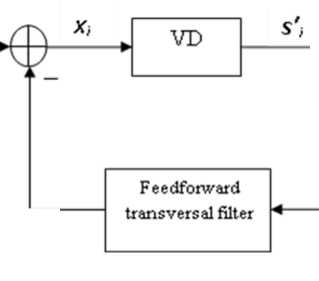
Feedforward transversal filter
Combined Detector-2(CDR2)
This detector is comparable to CDR1, with the exception that it begins using correct discovered data symbols (si) from the known retraining period at the end of the training period. As a result, at the end of each retraining period, the intersymbol interference (which is the second part of Eq. 6) will be correctly cancelled. Fig. 3 depicts the transmission order of information data and training. Communication systems currently employ retraining [2, 9].This detector employs it.
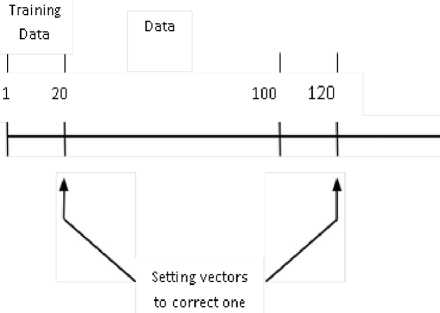
Fig. 3. Retrainingcase
Simulation results
To find out how well the three types of detectors, NLE, CDR1, and CDR2, tolerate AWGN when operating across telephone channels, a series of computer simulation tests have been run on the system in Fig. 1.
By plotting symbol error rate (SER) vs signal‑to‑noise ratio (SNR), the performance of the entire system is evaluated. SER is provided by
The performances of the three detectors are shown in Fig. 4. The performance of CDR2 appears to be 2 dB better than that of CDR1 at an error rate of 10–5. Additionally, CDR1's performance is 0.6dB better than NLE's performance.
Summary and conclusion
On the basis of computer simulation, a bandpass transmission system model was created. The system uses a QAM signal that is transmitted through a telephone channel to operate at a rate of 9.6 kbps. This simulation has utilized the NLE, CDR1, and CDR2 detectors. The outcomes demonstrate that CDR1 performs better than NLE, but less well than CDR2.
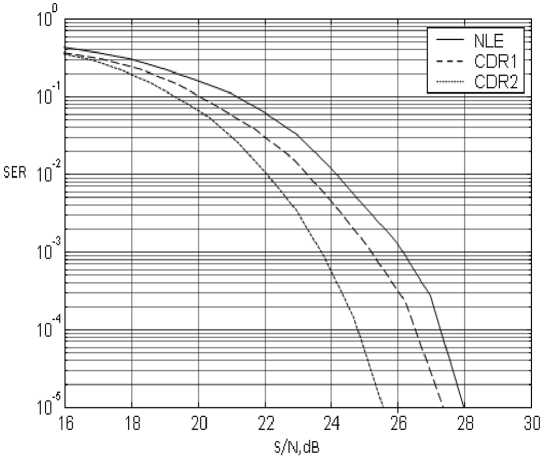
Fig. 4. Error rate performance
Список литературы Retraining data sequence for combined detector
- Al- Rawi M. Adaptive near maximum likelihood detector. International Review of Applied Sciences and Engineering. 2016, 7(1), 1–5.
- Abdullah S. Improved data detection processes using retraining over telephone lines. Journal of Engineering. 2009, 15(1), 3336–3346
- Bergmans J. et al. On the use of decision feedback for simplifying the Viterbi detector. Philips Journal of Research. 1987, 42(4), 399–428.
- Clark A. Equalizers for digital modems. Pentech Press 1th Edition. UK. 1985
- Chien- cheng T. based decision feedback equalizer with maximum likelihood sequence estimation for wireless receivers under multipath channels. US Patent 7197094. 2007.
- Forney G. Maximum likelihood sequence estimation of digital sequences in the presence of ISI. IEEE Transactions on Information Theory. 1972, 18(3). 363–378
- Forney G. The Viterbi algorithm. Proceedings of IEEE. 1972. 61(3). 268–278
- Maggio G. N., Hueda G. M. and Agazzi O. Reduced complexity MLSD receivers for nonlinear optical channels. IEEE Photonics Technology Letters. 2014. 26(4). 398–401.
- Olivier J., Sang- Yick L. and Chengshan X. Efficient equalization and symbol detection for 8-psk EDGE cellular system. IEEE Transaction on Vehicular Technology. 2003. 52(3). 525–529
- Rusek F., A. Prlja A. Optimal channel shortening for MIMO and ISI channels. IEEE Transaction. Wireless Communications. 2012. 11(2). 810–818
- Stephen A. & Quinn L. High performance equalizer having reduced complexity. US Patent 20100202507. 2010.
- Zheng N. and Zhang T. Design of Low- Complexity 2-D. SOVA Detector for Shingled Magnetic Recording. IEEE. Transactions on Magnetics. 2015. 51(4). 1–7

